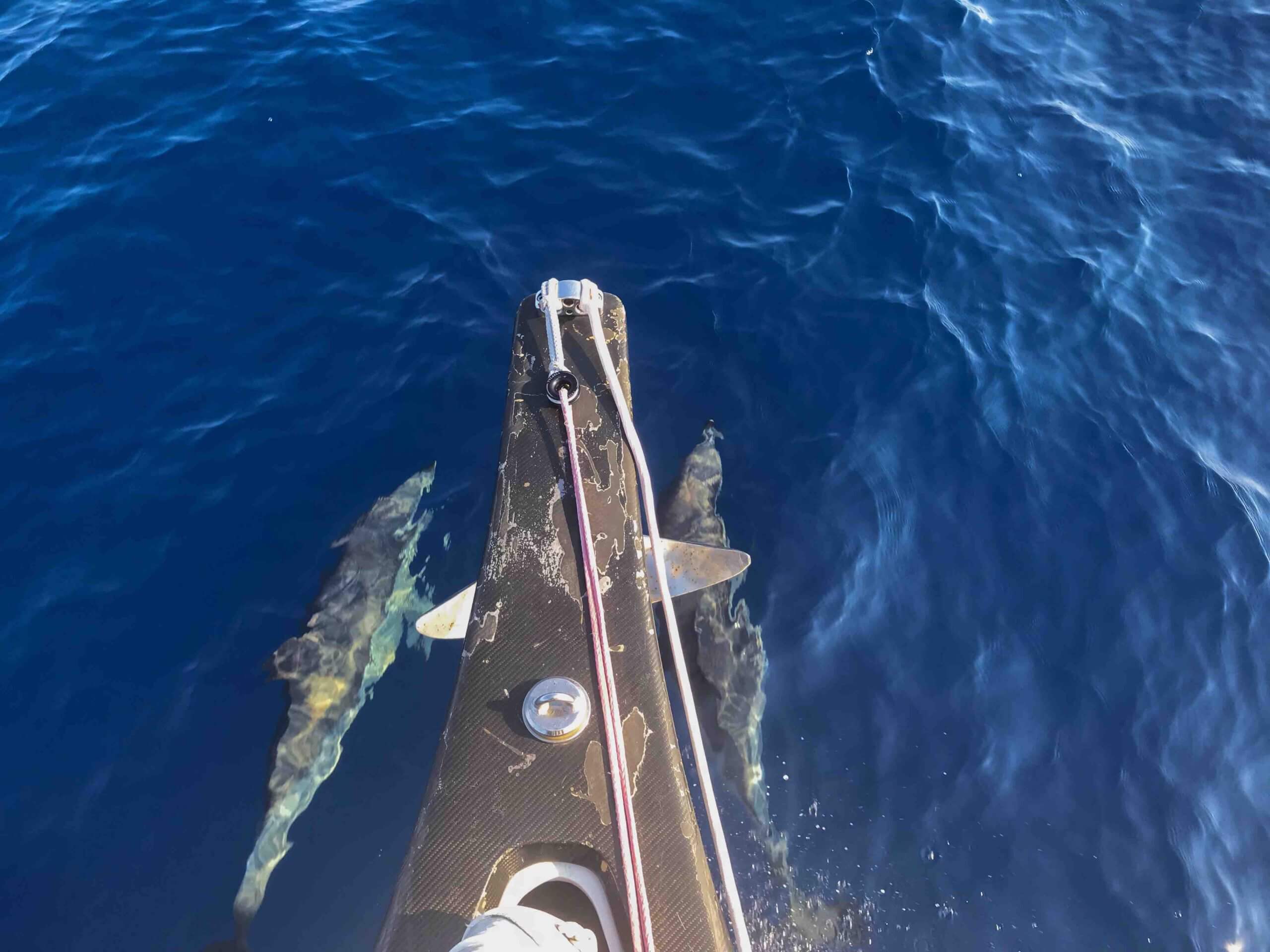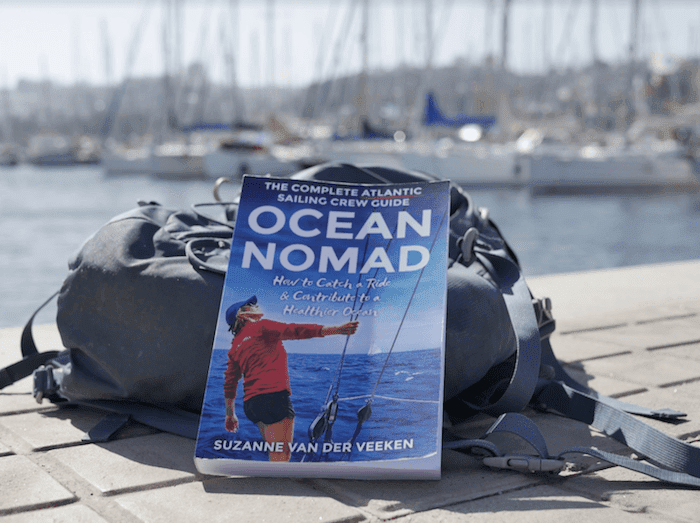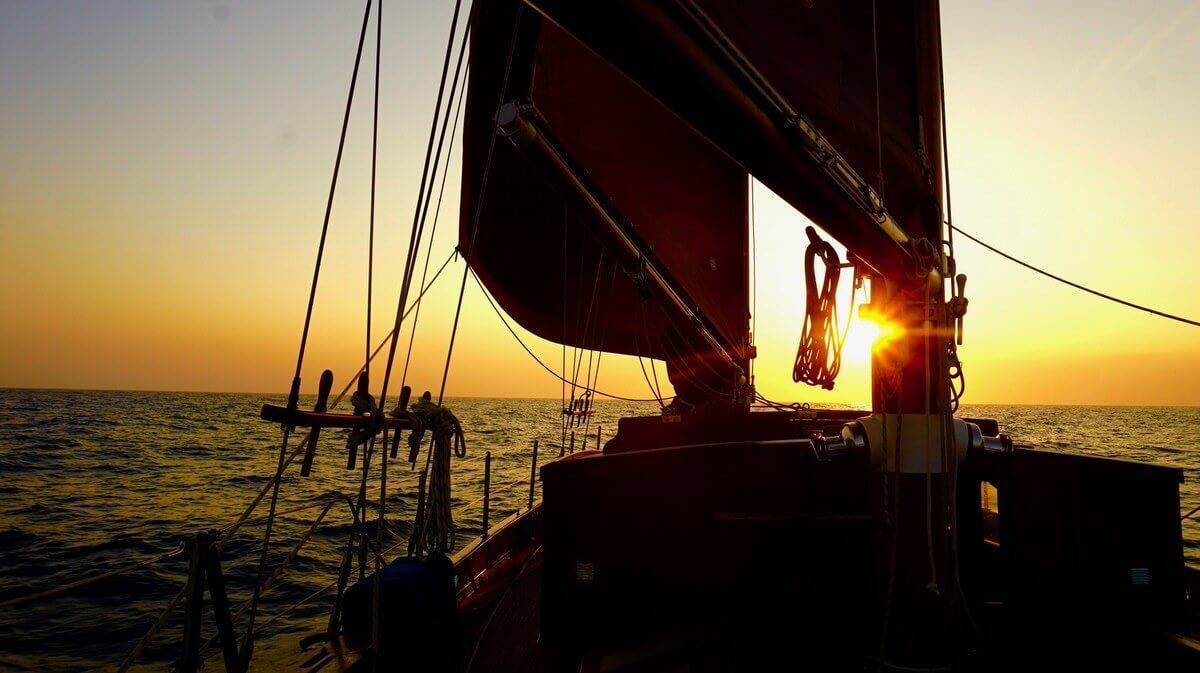How to prepare the offshore sailing gear kit, assess the safety, and minimize risk as crew before sailing an ocean?
Even in this era of satellite phones, safety and rescue technology, and communication systems, the nearest help on an offshore sailing passage can still be hundreds of miles away when sailing across an ocean. What can happen on an ocean crossing? A lot! You can get sick, fall overboard, hit something, lose the rig, have a fire, get water in the boat, rip the sails, break a leg, or in the worst-case scenario, sink. Airplanes crash. Cars crash. So do boats. To be blunt, shit happens. The Atlantic has no reefs or rocks in the middle, so the risk factor of hitting something is extremely low. Still, you could hit another boat, a whale or a floating container. These are rare scenarios, but it could happen. You need to rely on yourself. That’s why it’s so important that the boat is as safe and as prepared as it can be. And so are you as offshore sailing crew! To be ready to expect the unexpected, careful investigation and preparation is essential. Get ready with your offshore sailing gear, seamanship skills, and mindset!

sailing across the atlantic as crew
How can you minimise risk and negative consequences as a crew member? What to be alert for as ocean sailing crew? What to consider for safety offshore sailing gear for crew? What can you do as crew to prepare?
Here is an offshore sailing safety checklist for crew
Check the state of the boat
Your life depends on the condition of the boat. Check (or have someone to check) the hull, rig, sails, pumps, engine, and sails. Have new installations been tested? Are there spares and kit for repairs? Is there enough carrying capacity for fuel and water and back up water?
Check safety equipment on board
Make sure that the boat you hop on has the essential and preferably recommended (serviced) sailing safety gear and measures, like communication technology (VHF, Satellite phone), radar, radar reflector, foghorn, a liferaft, man over board equipment flares, fire fighting equipment, EPIRB, a manual bildgepump, a bucket, extra lines, a storm sail, storm anchor, spares, spares, and spares. (Find explanations and checklists in Ocean Nomad).
Check and prepare personal offshore sailing gear
What to bear in mind in terms of offshore sailing gear for crew? What needs to be in your offshore sailing kit? Be sure that you as crew have a life jacket and safety line. An ocean- worthy offshore life jacket is different from the one they have for you on the ferry or below your airplane seat. Captains often provide these but certainly not always. Be sure there is one for you on board. The most comfortable one will be one that is your own. Consider investing in one yourself. You will wear it for dozens of hours during the ocean crossing. They come in all sorts and sizes. Life jackets are graded by flotation capacity. A 150N (N stands for Newton and refers to how buoyant they are) jacket is the minimum recommended standard for offshore sailing. Life jackets should at least have a light, reflector and spray hood. Also, harnesses should be on board, so you will able to clip yourself. Life jackets carry gas cylinders to inflate them (check if they are serviced). If you are planning to fly with a life jacket, contact the airline in advance to receive approval to carry one.
Reduce risk especially if you’re planning to join sailing regattas and races and get yourself a pair of gloves. Fingers don’t like to be caught in winches.
A pocket knife/ yacht knife can be a useful item in the offshore sailing gear kit for rigging, fixing, cutting, measuring, chopping. Boats have tools too; it’s not a must. But who knows, it may save your life in an emergency! If you pack a knife, pack one with a blade that can cut a rope.
Be water proof. You can have all sorts of weather: from freezing cold and wet to tropical heat. Most likely you will have some chilly days and squalls. The northern route requires more warm clothes than the southern route, and wet weather gear is a must. The answer: bring layers! You’ll thank yourself for having a good waterproof jacket and for having a dry set of clothes. It would be more comfortable to have foul weather sailors’ jacket and pants, but you don’t need advanced offshore sailing gear just for the crossing.
Find an offshore sailing gear checklist in book Ocean Nomad. Here I wrote a blog with a summer sailing packing list from which you could take away some sailing tips too.
Assess competence on board
To a large extent, the state of the boat is also a reflection of the captain’s personality and capabilities. Do your research on the background of the boat, captain and fellow crew. The people you share the adventure with either make or break the experience. Realize that anyone can buy a boat without experience or license. It is vital that you get along with the people on board, trust in the captain’s abilities, and feel safe. Learn as much as you can about the captain, crew and boat to figure out the state of preparation. Meet up beforehand, fix things together and go for a sail. This will give you an insight into the captain’s personality, values, competencies and problem-solving skills. And it works vice versa of course. Make sure you get an offshore sailing crew safety briefing. Find the checklists in book Ocean Nomad. Having doubts? Consult the Ocean Nomads network.
Be insured | Offshore sailing crew insurance
- Be sure that the ship has proper offshore sailing insurance and that you are not financially liable in the event of major damage or even worse, a sunken boat.
- Make sure that you have good travel and liability sailing crew insurance. I recommend TopSail for offshore sailing crew insurance. For medical travel insurance for nomads SafetyWing can be a good solution. It works with many nationalities and can be obtained on the way. Last time I checked it has also offshore sailing insurance.
Have a backup plan
Sailboats deal with seasons, routes, weather, breakage, and all sorts of variables. By thinking about scenarios in advance makes it easy to peacefully change course and comply with Captains’ calls. Should the trip not go as planned, have a backup plan, including an emergency budget to sustain yourself or to book a flight, should the trip not go as planned.
Check the drinking water situation
Calculate if there’s enough water on board, and if a backup system is in place (such as a water maker, or two tanks, with one closed). Think about:
-
- The number of crew, length of the passage, capacity of the water tank, estimated days of sailing + extra emergency days. Each person needs at least three liters of water for drinking only.
- Make sure there’s a backup plan for contaminated tank water. If there’s only one water tank, you need to have backup water, just in case the tank gets contaminated or salty.
- Bring a filter water bottle for yourself so you can filter water at all times. My go to purification system at the moment is Maunawai. I wrote a full review here.

Develop seamanship skills
Know the bearings. Work on your offshore sailing skills. Learn about the passage, seasons, distance, destinations, weather, costs, and tasks involved.

Map of Atlantic Crossing Sailing Routes. Originally published in Ocean Nomad – The Complete Atlantic Sailing Crew Guide
Learn the basics of how to use the radio. Note that only those with a VHF certificate or with the assistance of a certificate holder you are allowed to use the radio. It’s not a toy. If there’s one thing you learn about radio, learn how and when to do a Mayday call.
Learn the essential knowledge regarding the Rules with other vessels. NauticEd has a free course on navigation rules.
Learn how to read the weather, on charts as well as from changing weather patterns when looking around. This can literally be a lifesaver! Being up-to-date on the weather is the most sensible prevention measure you can take to reduce risk. Study the weather patterns on your planned route, and learn how to read grib files, simplified low data weather data charts. Learn about weather patterns and reading with this NauticEd course. Also, Coursera has a good free course on Meteorology.
Learn about sea survival, maintenance of safety gear, life rafts, storm sailing, firefighting, search and rescue procedures, seasickness, and communication at sea. If you have the budget for a course, consider obtaining the STCW10 certificate. This is a basic safety certificate where you learn about personal safety and survival, firefighting, first aid/CPR, and personal safety and social responsibility.
Be prepared for first aid
Have someone (or a good book) on board with first aid knowledge.
Make sure there is a well-equipped medical kit on board, including prescription drugs and pain relief.
If no one on board has specific First Aid knowledge, is there a specialist contact you can call with the satellite phone in the event of an emergency?
Prepare for seasickness
Most people, including captains and professional crew, get seasick, some more severely than others. It’s quite normal, especially during the first few days of an ocean passage. How to prepare for seasickness?
- Have seasickness medicine, ginger candy, biscuits and mineral electrolyte solution as part of your kit. Test seasickness medicine before to see how your body reacts.
- The day before:
- Eat super healthy and light.
- Be well hydrated. Drink plenty of water. Don’t drink alcohol, coffee or black tea. That dehydrates.
- A few hours before sailing out:
- Take seasickness medication.
- Have your clothes, head torch, sunscreen, water bottle, sickness bag, and all you need for watch and sleeping, ready to grab. You’ll be okay doing watch, and you’ll be fine lying on your back in bed with your eyes closed. It’s just the areas between bed and cockpit that are the challenging zones to navigate when you’re seasick.
- Have some crackers ready to nibble on.
I usually get seasick first day at sea. But I know how to deal with it and remain a competent crew. I prefer seasickness over the side effects of seasickness medication. It makes me a more useful crew member. More on dealing with seasickness.
Take care of your health and comfort
We can only be our best if we feel our best. As offshore sailing crew you are on board to help everything run smoothly, so better stay healthy onboard. Be and stay fit, so you can deal with any situation that crops up. Besides seasickness, a few of the biggest health risks on board are sunburn, dehydration, food poisoning, insect bites, wounds, contaminated water, and just general well-being. How can you personally prepare to stay on top of your health on an ocean crossing?
- Be well rested before the crossing.
- Rest well when you are not on watch. Is your boat bed rocking-proof? Do you have a lee cloth? If not, make one. You won’t be the first being thrown out of bed.
- Do you have a specific diet, allergy or medical condition? Prepare for that yourself and inform fellow crew in advance.
- Any tooth problems? Have it checked before you go! There’s no dentist on the ocean.
- Bring a reusable water bottle and have it with you to remind yourself to drink enough.
- Also, include a filter water bottle as part of your kit, so you have clean drinking water at all times and can drink straight from the tank in case the boat doesn’t have a water filtration system (yet!).
- Start fit and stay fit. See the health kit in Ocean Nomad for more suggestions on what to bring. Also, provisioning makes a huge difference to how you will feel for the weeks at sea. At the Ocean Nomads membership portal we have a big resource on provisioning and waste management at sea.
- Wear a cap, sunglasses, and mineral-based sunscreen.

About the set sail for the fourth Atlantic Crossing
Be able to communicate
Is there a satellite phone on board? Or another device to send/receive data at sea for weather info and/or emergencies? The most important is that there is a way to check the weather.
- Make sure the communication equipment onboard has been tested.
- Save emergency numbers in the satellite phone and write them down and put them in a visible spot.
Have a Personal GPS tracker. A personal tracking GPS device is a cost-effective possibility that allows text communication, location tracking, and emergency alerts in the unlikely event that you get lost at sea, or anywhere. A personal GPS tracker device may be welcome to have if you’re doing solo watches or plan to explore foreign lands on your own after the sailing adventure. Above all, don’t fall overboard. Ever. I only got a personal GPS tracker this year and wished I got it from my very first offshore sailing passage. Since last Atlantic crossing with 50 knots of wind and solo watches, I’m not compromising on this safety device. After a serious investigation of personals locator beacons the best personal GPS tracker I found is the Garmin Inreach Mini. Still affordable, as small and light as it can get and with 2-way communication possibilities.
Know the boat
Learn how the boat works as soon as possible. Walk all the lines. Observe, learn and memorise. Learn how the different systems on board work. Know where all safety equipment is located (Grab bag, flares, life jackets, fire extinguishers, life raft, MOB gear, first aid kit). If something happens to the skipper and/or other capable offshore sailing crew, someone’s got to be able to take over.
Don’t forget to tell mum
Make sure someone knows where you are. Give the home base contact details, such as the satellite phone number, captain’s number, and details of crew members and their family.
Show your family/friends how to use marinetraffic.com. If the boat you are on has an AIS transponder, you are traceable in the VHF radio zone. Tell them that the boat can disappear from the radar when you’re out of the radio zone (+/– 50 miles from coast). You don’t want them to call Search & Rescue because your boat has disappeared from the map! Mums have done this before and it can turn out to be a costly call.
Nearly all boats making an ocean crossing will have satellite phone and/or SSB radio on board. Both systems can send and receive text and email when you’re out of the coastal radio zone. They are expensive to use, so don’t expect to be able to call home except in an emergency. Family and friends can often send messages to the phone for free though, so that’s cool!
Some boats may have a tracking device that sends out a GPS signal every hour or so your family and friends can trace you. The Garmin Inreach I have also does that.
Fair winds!
On every offshore sailing passage things will happen. It’s all part of the adventure. Hop on board with an ‘it can be done’ attitude, be inventive, alert and well-prepared, and you can tackle whatever situation comes up.
All you really need is water, food, a compass, and a (paper) chart of the Atlantic. The rest is a bonus, safety measure, or an extra headache. Equipment can make the ride more comfortable and safe but also more complicated. Every addition costs maintenance and money. Every boat has its problems. Boat works are ongoing. Stuff breaks and has to be repaired all the time, so don’t freak out. This is perfectly normal. And you actually learn most on boats where things break. It just makes it extra important to figure out if the captain and crew are well prepared, competent and positively vibed. If something is nagging inside of you, don’t do it. Follow your instinct. Opportunities come along all the time.
There will always be a risk. But what’s life without it?
There is a lot more to say about offshore sailing crew preparations and safety. That’s why I wrote a book :) Learn more about finding and assessing rides across the Atlantic in Ocean Nomad: the Complete Atlantic Sailing Crew Guide – Catch a Sailboat Ride & Contribute to a healthier ocean. Grab your copy to be well prepared and sure about your offshore sailing crew ride!
Or grab a print edition here on my website in a bookstore near you, at Bol.com or Amazon.
Do you have more questions? Write in the comments, contact me for a virtual coconut or join the ocean nomads family where you can tap into nomad travel and sailing tips, knowledge, network and support from many sailors.















